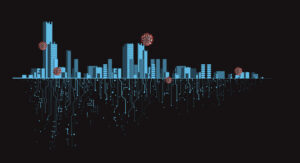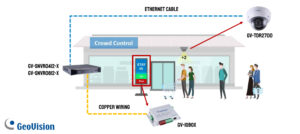
When it comes to how traditional security technologies can help smart buildings fight COVID-19, there are some obvious answers. For example, the benefits of contactless access control systems and mobile credentials are clear — less touching of surfaces means a lower probability of virus transmission. On the other hand, while the security implications for video surveillance are quite clear, how they can help fight against coronavirus might be less clear.
Today, deploying smart cameras capable of running multiple AI-enabled applications directly on the camera essentially turns the device into an IoT sensor that can be used for a variety of purposes. In terms of COVID-19, some of these functions include help with social distancing, enforcement of face mask mandates and monitoring of occupancy levels.
Smart cameras for people counting, occupancy management

New social distancing guidelines have made knowing exactly how many people are in a building and where they are very important.
Many public buildings made a quick solution in putting an interim employee at the front who was in charge of counting the people going in. This, however, is only a short-term solution as it is not viable to be used in the long run.
Instead, building managers and owners are looking for more practical solutions to manage tenant and visitor traffic flow. From a PSIM integrator point of view, it is important to have smart camera systems as part of the solution. They are capable of counting persons going in and out, as well as notice if they are indeed holding their distance.
But how can smart cameras equipped with people counting detectors, partially or fully automate occupancy management in commercial buildings?
Once max occupancy has been reached, building, or business managers, will receive a notification alerting them to take appropriate action. For a fully automated system, smart cameras can integrate with a video screen at the access point, which will feature an alert system similar to a traffic light to regulate admittance.
Going further than people counting, crowd detection applications can detect people and the distances between them to provide a more comprehensive occupancy report. Data from these applications offer a picture of crowd density across an entire space, such as a retail store or building lobby. This is particularly ideal for larger buildings.
Data generated from crowd detection applications provides building managers with the necessary information to make adjustments to building layout in order to remove chokepoints where visitors get too close to one another.
By placing smart cameras near checkouts, lobby entrances and exits, escalators and other potential chokepoints, building managers can determine if increased signage that encourages social distancing is needed.
Smart camera integration with HVAC, lighting and more

Smart cameras can also be used in commercial smart buildings to improve the user experience by detecting room occupancy and communicating with the HVAC system to adapt air conditioning and heating levels. They can even be used to help assess the cleanliness of an area, record the last time the area was sanitized, identify if conference room lights or devices have been left on, and notify personnel of stock items needed in office break rooms.
Adapted from a&s Magazine



































































